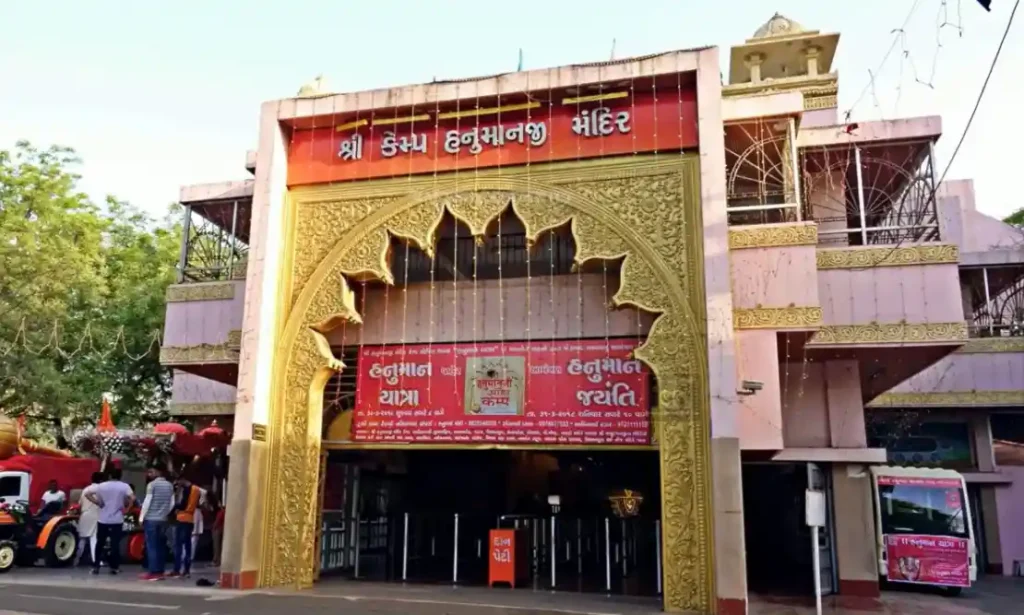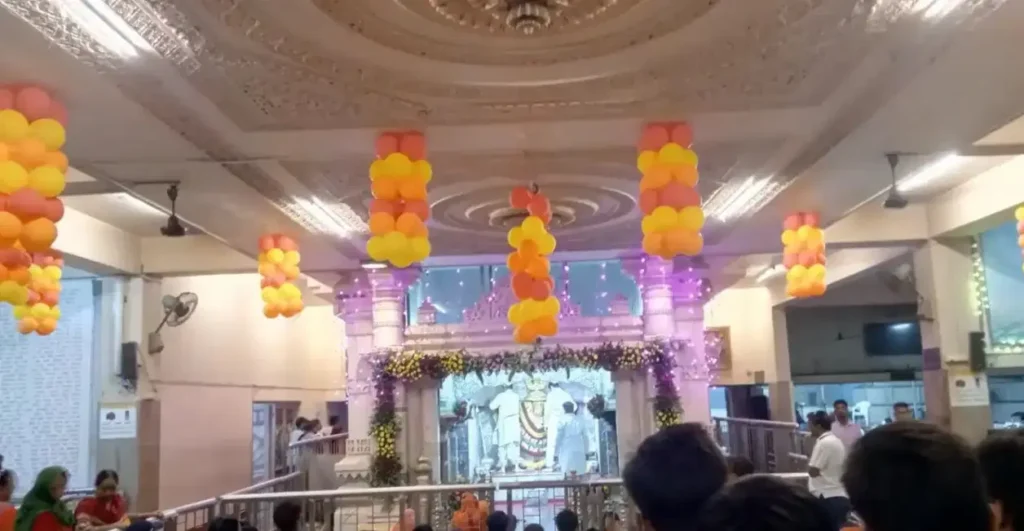Nestled in the vibrant city of Ahmedabad, the Camp Hanuman Temple stands as a cherished spiritual landmark, inviting devotees and visitors from all walks of life. This sacred temple, dedicated to Lord Hanuman, the revered Hindu deity of strength, courage, and devotion, is a beacon of faith and resilience.
With a rich history that intertwines with the cultural fabric of Gujarat, the temple’s significance goes beyond its ancient walls, offering a profound spiritual experience for anyone who steps inside.
Join us as we uncover the unique architecture, powerful legends, and profound practices that make the Camp Hanuman Temple not just a site to see but a sanctuary for the soul.

Significance of Hanuman in Hinduism
In Hindu mythology, Lord Hanuman is a symbol of his incredible strength, courage, and deep loyalty to Lord Rama. He represents the true spirit of devotion, demonstrating how love for the divine can lead to amazing physical and spiritual feats.
For many followers, Hanuman stands for selflessness, humility, and the ability to overcome obstacles, making him a powerful source of inspiration and protection.
Visiting the Camp Hanuman Temple allows devotees to connect with these qualities, as the rituals performed there are designed to build inner strength and resilience. People believe that calling upon Hanuman can help eliminate fear, boost courage, and bring about mental peace.
History of Camp Hanuman Temple
The Camp Hanuman Temple has a rich history that dates back over a hundred years, founded by Pandit Gajanan Prasad. The temple houses an idol of Lord Hanuman that is believed to be over 350 years old, making it a revered religious symbol.
Throughout its existence, the temple has been a witness to significant historical moments, especially during the colonial period when local worshippers rallied against efforts to move it.
According to local lore, when an English official ordered the temple’s destruction, thousands of devotees gathered around it, successfully thwarting the demolition. This remarkable event was attributed to divine intervention, as swarms of wasps attacked the workers assigned to the task, leading to a halt in the operation.
In 1952, the temple was handed over to the Shri Hanumanji Mandir Camp Trust Ahmedabad, which has since been responsible for its upkeep and management, ensuring that it remains a cherished site for future generations.
The temple has also attracted notable visitors, including former Prime Ministers Indira Gandhi and Atal Bihari Vajpayee, highlighting its significance in India’s cultural and political landscape.

Architectural Features of Camp Hanuman Temple
The Camp Hanuman Temple in Ahmedabad is a blend of traditional Hindu temple design and local Gujarati architectural styles. Here are some of the key architectural features that make this temple unique:
The shrine has a monumental entrance gate decorated with elaborate carvings. These carvings depict various scenes from Hindu mythology, showcasing the rich cultural heritage of the region. The gate serves as a grand welcome to devotees and visitors, setting the tone for the spiritual experience that awaits inside.
The main sanctum sanctorum houses a gold-plated statue of Lord Hanuman, which is the focal point of worship. The idol is often decorated with marigold flowers and garlands, exuding a sense of divine strength and tranquility. The sanctum is designed to create a serene and spiritual atmosphere, allowing devotees to connect deeply with their faith.
The walls of the temple are adorned with inscriptions of Lord Rama‘s name. These inscriptions are a testament to the devotion of the temple’s builders and the enduring faith of its visitors. The repetitive chanting of Lord Rama’s name is believed to bring peace and spiritual upliftment to those who visit the temple.
The temple complex features numerous additional shrines dedicated to various deities. These shrines allow worshippers to make prayers and request blessings from various deities, enriching their spiritual experience.
The temple is equipped with facilities to accommodate the needs of its visitors. This includes areas for meditation, rest, and refreshment. The temple management ensures that the environment remains clean and welcoming, making it a comfortable place for worship and reflection.
One of the unique aspects of Camp Hanuman Temple is its spacious courtyard. This area allows for large gatherings, especially during significant festivals like Hanuman Jayanti and Ram Navami. The courtyard promotes a sense of community among devotees, enhancing the temple’s role as a social and spiritual hub.
The architecture of the Camp Hanuman Temple is a harmonious blend of traditional Hindu temple design and local Gujarati style. This fusion is evident in the temple’s structural elements, decorative motifs, and overall aesthetic. The use of local materials and craftsmanship adds to the temple’s unique charm and cultural significance.
Camp Hanuman Temple, Ahmedabad- Location and Accessibility
The Camp Hanuman Temple is a famous pilgrimage site in Ahmedabad. It has many facilities to make your visit comfortable and meaningful. It’s located in Shahibaug, within the army cantonment area. There’s plenty of parking outside the main gate for everyone.
The Camp Hanuman Temple is 7 kilometers from Ahmedabad Junction. It’s in the Cantonment area of the city. It’s close to Kalupur Railway Station, 4.5 kilometers away, and 5.8 kilometers from Sardar Vallabhbhai Patel International Airport. You can also get there from Geeta Mandir Bus Stop, 8.1 kilometers away.
To get to the Camp Hanuman Temple, park outside the main gate. Then, walk half a kilometer into the Cantonment area. The temple offers battery-operated shuttles for senior citizens. This makes it easy for everyone to visit and enjoy the spiritual experience.
The Camp Hanuman Temple is in the Cantonment area. This adds to its historical value. It’s also close to major transport hubs. This allows individuals to come from various locations without difficulty.
The temple also has a small canteen that serves tasty vegetarian food. This adds to the overall experience. Visitors can enjoy the temple’s beauty, sacred spaces, and delicious food, making it a complete visit to the Camp Hanuman Temple in Ahmedabad.

Temple Timings and Visitor Information
The Camp Hanuman Temple is generally open to visitors from early morning until evening, with precise timings as follows:
Morning: 6:00 AM to 12:00 PM
Evening: 3:30 PM to 9:00 PM
There is no entry fee, and visitors are encouraged to dress modestly as a mark of respect. Maintaining a quiet, respectful demeanor within the temple premises is highly encouraged, allowing all visitors to immerse themselves in the peaceful atmosphere.
Camp Hanuman Temple- accommodation
When visiting the Camp Hanuman Temple in Ahmedabad, there are several accommodation options nearby that cater to different preferences and budgets.
For more budget-friendly options, there are several guesthouses and budget hotels in the vicinity of the temple. These accommodations offer basic amenities and are ideal for stays.
Festivals and Celebrations
The temple tends to be particularly busy on Tuesdays and Saturdays, as these days are regarded as auspicious for honoring Lord Hanuman. A major occasion at the temple is Hanuman Jayanti, which celebrates the birth of Lord Hanuman.
During this festival, a grand procession is taken out, and thousands of devotees participate in the celebrations. The temple also organizes various religious and cultural events throughout the year, fostering a sense of community and devotion.
♣♣You May Also Like: ⇓
- Noted Sharda Peeth: Unveiling Its Rich History & Culture
- Noted Narayani Temple, Odisha: A Divine Journey
- Dreamy Navlakha Temple, Ghumli, Gujarat: A Sun God’s Abode
- The Magnificent Brahma Temple: A Sacred Abode of the Creator
- Wonderful Wat Huay Pla Kang In Chiang Rai, Thailand
Conclusion
The Camp Hanuman Temple in Ahmedabad is more than just a religious site; it is a symbol of faith, community, and cultural heritage. With its rich history, stunning architecture, and vibrant rituals, the temple attracts countless devotees and tourists alike.
For those seeking spiritual solace or a glimpse into the traditions of Hinduism, a visit to the Camp Hanuman Temple is a must. As one steps through its doors, they are not just entering a temple; they are stepping into a world of devotion, history, and community that has flourished for decades.
FAQs:
1. What is Camp Hanuman Temple?
Camp Hanuman Temple is one of the largest and most revered Hanuman temples in India, located in the Cantonment area of Ahmedabad.
2. What is the significance of Lord Hanuman?
Lord Hanuman is a central figure in Hindu mythology known for his strength, devotion to Lord Rama, and protective qualities.
3. Is there an entry fee to visit the temple?
No, entry to Camp Hanuman Temple is free for all visitors.
4. How can I reach Camp Hanuman Temple?
Visitors can reach the temple by local transport like buses and autorickshaws or by car. Parking is available outside the main gate.
5. Are there any security measures at the temple?
Yes, due to its location in an army cantonment area, visitors must comply with security protocols and carry valid identification.
6. What facilities are available at the temple?
The temple has a canteen that serves vegetarian food and offers battery-operated shuttles for senior citizens.
7. Is Camp Hanuman Temple accessible for differently-abled individuals?
The temple provides battery-operated shuttles for those who may have difficulty walking long distances.
8. What should I know before visiting the temple?
Be prepared for security checks and maintain a respectful demeanor during your visit.